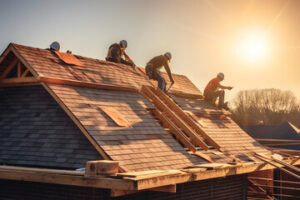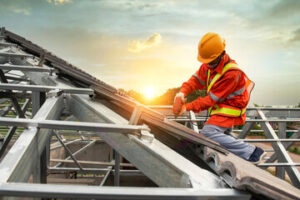The roof protects the rafters, walls and foundation of the building from weather damage. It is important to regularly inspect and repair any roofing problems as soon as they appear.

Cleaning gutters helps to direct water away from the roof. Resealing flashing around chimneys and vents will prevent leaks. Contact Erie Roofing for professional help.
Shingle roofs are exposed to a lot of natural perils—sun, wind, and rain are just some of the many hazards that can damage shingle structures. Whether it’s the result of harsh weather or wear and tear, a damaged roof can leave you with costly repairs. Fortunately, understanding common shingle damage signs can help you stay on top of roofing maintenance to keep your roof looking great and functioning effectively.
Shingle Damage
One of the most common forms of shingle damage is curling and buckling. This is caused by an accumulation of moisture in the attic or a lack of ventilation, which causes shingles to become brittle and weak. When this happens, shingles are at an increased risk of being torn from the roof and allowing water to seep in.
Curling shingles may also indicate other problems that need to be addressed. If the roof isn’t properly vented through soffit, ridge or gable vents, hot air can become trapped in the attic, causing moisture to build up. This can cause the shingles to become brittle and develop a concave shape in the center. In addition, the excess heat can cause granules to become dislodged from the shingle and deteriorate over time.
Inspecting shingle damage often requires climbing onto the roof, so it’s important to use a safe ladder and prioritize safety. If you’re concerned about shingle damage, be sure to contact an expert to schedule a roof inspection. A professional can identify issues that are easy to miss, like water stains on the ceiling or walls.
Depending on the severity of the damage, a professional can suggest ways to prevent further damage and restore the roof’s function. In the case of shingle damage, this might include adding bracing and hurricane straps for added stability or installing impact-resistant shingles. In addition, regular roof inspections are recommended to ensure that the shingles are in good condition and have adequate support. It’s also important to trim any trees around the house, and regularly clean gutters to avoid debris buildup that can lead to clogs and water backup.
Standing Water
If water ponds on your roof after rainfall, it can cause major damage to your home or business. It will decrease your roof’s lifespan and lead to a more frequent need for repairs. It can also affect the walls and structure of your property. And if it’s left unattended, it can even lead to a roof collapse.
Stagnant water attracts mosquitoes, flies, roaches, termites, rodents, and other pests. These insects thrive in wet conditions and can carry diseases that may put your family or employees at risk of illness. They can also damage wooden structural supports on your property and leave behind rotting wood.
Standing water can also pose a serious health threat to your family or employees if it becomes infested with mold and mildew. These allergens can irritate your nose, throat, and skin, causing respiratory problems. They can also exacerbate allergies and asthma. In some cases, they can also cause more severe health issues like lung disease and even cancer.
Water accumulated on the property can damage the foundation and cause cracks in walls, floors, and ceilings. It can also leach contaminants into the walls, drywall, and insulation of your house. This is particularly a problem in old homes where the shingles and wood can rot.
If you are unsure if your roof is experiencing ponding water, examine it 2-3 days after significant rain when the weather is warm and sunny. This will allow the water to evaporate more easily.
The most important thing you can do to protect your home or business is to have a professional inspect the area and determine the causes of the issue. A qualified roofing contractor can identify the areas in need of repair, recommend preventative measures, and install new gutters to help solve the standing water problem. To learn more about how our team can help, contact us for an inspection today! We would be happy to answer any questions you have about your roof and how we can repair or replace it. We offer free estimates and are licensed and insured.
Mold & Mildew
Mold and mildew are more than just cosmetic issues that can damage shingles and compromise the structural integrity of your roof. They also cause a variety of adverse health effects including eye irritation, respiratory problems and more. While mildew is generally less harmful than mold, it can still cause sneezing, runny nose, itchy eyes and throat, sores, and even more serious health conditions like migraines and depression.
These problems occur as a result of excess moisture, often from improper roof venting and poor air circulation. Mold spores thrive in warm, humid environments and can quickly spread over large areas of your roof if not addressed immediately.
A common indicator of mold is discoloration on a home’s roof. Streaks or splotchy spots are typically green, black or brown in color and can lead to a number of severe health and safety issues.
Another common sign of mold is a musty smell. The earthy, rotting scent that accompanies most forms of mold is difficult to mistake for anything else and can indicate that mold is present on or near your roof. If you notice this smell, contact a professional immediately, as they can inspect your home for signs of mold and provide treatment services accordingly.
As previously stated, excessive moisture is the leading cause of mold growth and must be addressed immediately to prevent long-term damage. Leaking roofs are especially susceptible to this issue as they allow moisture to seep into insulation and wood materials, causing them to degrade over time. When this happens, the material can deteriorate and eventually reach your walls, where it can further compromise indoor spaces.
Regular cleanings and proper roof maintenance are the best ways to prevent mold and mildew from forming on your roof. Be sure to regularly clean your gutters and downspouts, and use exhaust fans in kitchens and bathrooms to redirect excess moisture away from the house. Additionally, using mold-resistant drywall and paints will help prevent the buildup of mold on the surfaces of your home. Finally, routine inspections and prompt repairs will ensure that your roof’s ventilation system is functioning properly, preventing excess moisture from building up in your attic or crawl space.
Fungus
Fungi are a diverse group of microscopic microorganisms with an extraordinary ability to adapt to different environments. They are able to absorb nutrients from the environment, which they store in an organic cell wall composed of chitin — the same material that makes up the exoskeletons of crustaceans and insects. Fungi are classified into five phyla, which are distinct from other living organisms but share similar characteristics.
Roof fungus, also known as mold or mildew, can appear as dark streaks or stains on your roof. This unsightly discoloration is due to a variety of factors, including high humidity levels and shaded areas. While the majority of fungus is not harmful, the presence of fungi on your roof can cause serious damage over time.
Fungus can weaken the structure of your roof, causing it to deteriorate and leak. Eventually, this may lead to structural issues inside your home, such as clogged gutters and water damage.
The best way to prevent fungus is to perform regular roof inspections and catch any signs of growth early. Keep in mind that the early stages of fungus can resemble dirt or grime, so a keen eye is necessary.
It is also important to trim any trees that are touching your roof and ensure that your gutters work properly. This will help to avoid excess moisture and encourage the drainage of rainwater, preventing the development of fungi.
Fungi can also be found growing in plant roots in a symbiotic relationship, where they provide plants with essential nutrients in return for sugars. These fungi are called mycorrhizal fungi, and they are well-known for their benefits to terrestrial plants. Fungi can be beneficial to green roofs as they can deliver nutrient-rich soil to the roof surface and improve drainage.
The health of your roof is critical to the overall integrity and safety of your home. By addressing potential issues like wet or dry rot, green algae and fungi, and standing water, you can extend the life of your roofing materials and save yourself from expensive and premature replacements. Fungus can be easily removed with a professional pressure washing, which is both effective and environmentally friendly.

